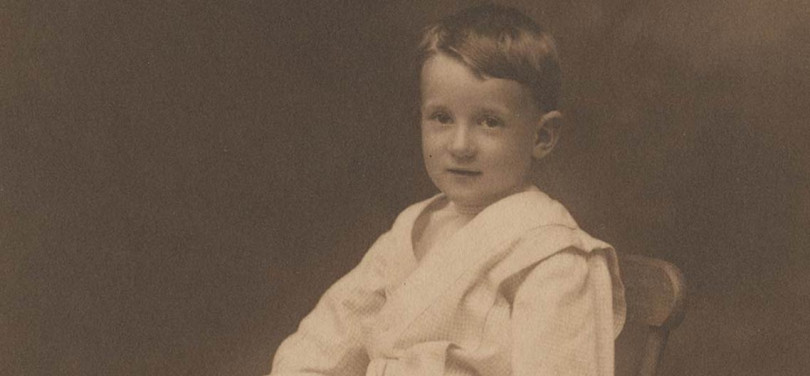
Reference Biography: Walter O’Malley
By Brent Shyer
The Early Years
At the turn-of-the-century in 1900, the relatively young sport of baseball was just hitting its stride, particularly in New York. Brooklyn had joined the National League of Professional Baseball clubs 10 years earlier and its team was known as the “Bridegrooms,” as a large number of players on the club were married the previous year. Later, the club was named for the complicated maze of trolley cars that weaved their way through the Borough of Brooklyn and residents became affectionately known as “Trolley Dodgers.” Headline writers of the time, didn’t always have space for the word “trolley” and eventually just left it out. So, they became simply the Dodgers, one of baseball’s most enduring and recognizable names.
Charles Ebbets, who at one time sold tickets and programs for the team, eventually worked his way up through the front office and became President of the Dodgers. Ebbets, too, realized a dream by building a beautiful new ballpark — Ebbets Field — which opened on April 9, 1913. Ebbets had to enlist the financial support of two brothers — Steve and Ed McKeever — who were in the construction business to finish the stadium which was fraught with cost overruns. Hard-pressed to pay the bills and complete the building process, Ebbets was forced to forgo one-half ownership of the Brooklyn franchise to the McKeever brothers. Two corporations were newly formed, as the Ebbets-McKeever Exhibition Company held real estate title to the land, while the Brooklyn National League Baseball Club took care of the business of baseball including player contracts. No grand opening of a ballpark ever seems to run entirely smoothly, as someone forgot to bring the key to open the grandstands on the first day and the game was slightly delayed!
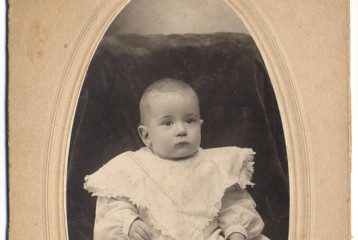
Walter O’Malley, age 2, Thanksgiving 1905
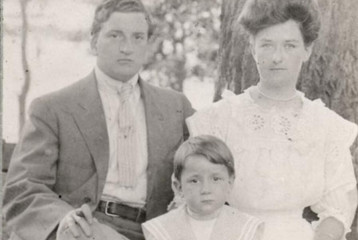
Walter O’Malley (circa 1907) with his parents, Edwin J. and Alma O’Malley.
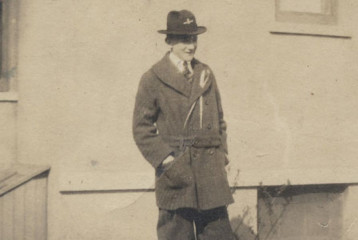
Walter O’Malley shown as an active member of the Boy Scouts, an organization which had a profound influence on him.
During this same period, Walter O’Malley was a young boy in bustling New York. Born on October 9, 1903 in the Bronx, he was the only child of Edwin Joseph O’Malley and Alma Feltner O’Malley. He grew up in a pleasant section of New York, moving from the Bronx when he was just seven to Hollis, Long Island. In Hollis, he attended Public School No. 35. O’Malley worked hard at his studies, but equally liked many activities outside of school, including swimming, fishing and boating. He also thoroughly enjoyed his experience as a Boy Scout, where he first went camping, hunting and “learned how to cook and make a bed.” O’Malley attended some professional baseball games and became a real fan of the sport.
“I used to walk along a railroad trestle, up at Morrisania, with an uncle of mine, Clarence Feltner, to watch the Giants,” said O’Malley. “We lived in the Bronx then and the Giants were my team and the most wonderful guy in the world was Eddie Brannick. Eddie was terrific to us kids. He’d see we got a seat if we got into the park — and there were ways. Ho, ho, there were ways.” Robert Shaplen, Sports Illustrated, March 24, 1958
New York in the 1910s was filled with immigrants and family-run businesses. Edwin, whose family history can be traced to County Mayo in Ireland, was prosperous in the dry goods business and later became the city’s Commissioner of Public Markets, an important appointed post.
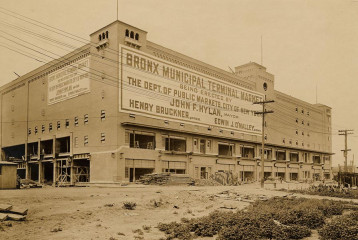
The sign above the office of Walter O’Malley’s father. Edwin J. O’Malley served as Commissioner for the Department of Public Markets.
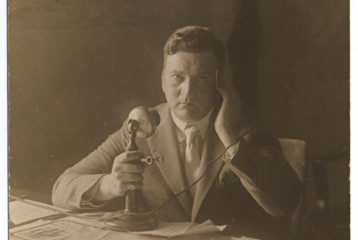
Edwin O’Malley initially began his career in the dry goods business.
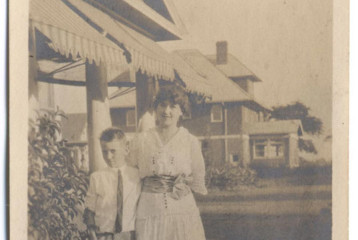
Walter O’Malley with his mother, Alma.
Edwin J. O’Malley was one of 14 children, the second of eight sons of Georgiana Reynolds and Thomas Francis O’Malley. Edwin was born on August 23, 1882 and lived to be 70 years old. Alma Feltner, Walter’s mother, was born on March 6, 1883 in New York City, the fourth daughter of German-born Dorothea Schmaus and F. George Feltner of Bavaria. Alma, who had four sisters and three brothers, passed away on June 1, 1940 in Amityville, NY.
Thomas’s parents were John O’Malley and Margaret Collins, who were married in County Mayo, Ireland before immigrating to the United States. Walter wrote a letter about his paternal grandfather Thomas, who was born on April 15, 1854, “In the late 1880s, he worked in the Brooklyn Post Office at a time when Brooklyn was a separate city and not part of the greater city of New York. His associate there was Albert Furman, who later became Postmaster of Brooklyn. Postmaster Furman was a respected and colorful figure in Brooklyn in those days. My late Grandfather...had been active in organizing an association of postal employees and that this effort was not appreciated at the time in Washington and that he was transferred from Brooklyn to San Francisco where he was assigned to the International Exposition in charge of the Post Office.
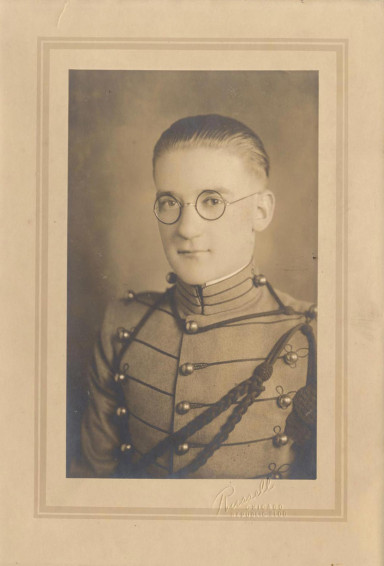
Walter O’Malley was a student at Culver Military Academy in Culver, Indiana in 1920-22.
“He was never Postmaster of San Francisco but perhaps had that title at the International Exposition in San Francisco. One of my uncles was born in San Francisco during this period and my father (Edwin) attended grade school there as did his brothers and sisters. As I get the story, and after perhaps 4 years, he was reassigned to Brooklyn under Postmaster Furman, who had requested his transfer. He spent his entire adult life in the Postal Service and was devoted to it.” Walter O’Malley letter to Otto K. Olesen, Postmaster, Los Angeles, September 12, 1960
Walter was 14 years old when Thomas passed away on January 15, 1918 in Brooklyn. Georgiana, however, lived to be 86, a vivacious great-grandmother who enjoyed retelling Irish stories learned from her parents.
O’Malley was a popular student with his peers. His parents wanted him to receive the best education available. After he had attended Long Island, New York’s Jamaica High School for two years (1918-20), O’Malley was sent to the strict Culver Military Academy in Culver, Indiana for two years in the Fall of 1920 to get the proper upbringing for a young man. He had earned the responsibility of assistant scout master in the Boy Scouts for five years. In the Culver Military School regulations handbook of 1917, it states, “Any cadet who shall conduct himself in a trivial manner, or present an unsoldierly appearance while on post or who shall be grossly ignorant of his duties after having sufficient opportunity for acquainting himself therewith, shall be relieved from duty and reported at once to the Commandant of Cadets.” Culver Military School Regulations Handbook, 1917
“I went to Culver and graduated there in 1922,” said O’Malley. “It was there that I thought I might become a ballplayer — I tried out at first base. I never did make the varsity team, however.” Walter O’Malley interview on KFI Radio with host Loren Peterson, 1965
O’Malley was a talented communicator who even traveled with and wrote a column for The Vedette student paper about the teams at his alma mater Culver Military Academy. In 1922, he was named associate editor of The Vedette staff. His fairly short baseball playing career ended at Culver when he was hit on the nose by a ball. A hot grounder to him at first base caromed off his nose, breaking it, leading doctors to advise him not to play without wearing his glasses, something that wasn’t in vogue at the time.
“Yes, they banged my nose open and I was also handicapped by the fact that I wore glasses and, at that time, there weren’t many players who wore glasses,” said O’Malley. Ibid. “I played a little baseball there, but I just wasn’t good at all.” Walter O’Malley interview with Vin Scully for Union Oil record series, 1966 He took to the sidelines and became a manager for the baseball team.
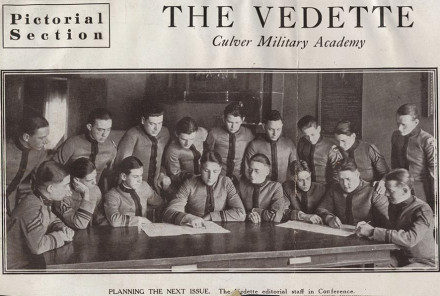
At Culver Military Academy, Walter O’Malley (front row, fourth from right), was associate editor of the school’s newspaper, The Vedette.
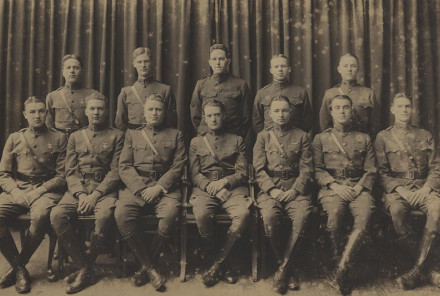
Walter O’Malley (front row in middle) was a member of the Scabbard and Blade Honorary Military Fraternity at the University of Pennsylvania.
Besides his parents’ strong influence, O’Malley would learn proper etiquette for behavior, dining and interacting with others at Culver. In the Roll Call yearbook at Culver for 1921-22, a description of O’Malley said, “A pleasing personality is perhaps his greatest asset, and with it he has won himself many friends. His next greatest feature is his home town, and although there may be many people in it, he is sure to come to the front before long.” Roll Call yearbook, 1921-22, Culver Military Academy, Page 118 He also learned how to properly shoot firearms in a safe manner. O’Malley earned a commission as 2nd lieutenant reserve in the U.S. Army in 1922 upon graduating from Culver.
O’Malley enrolled at the University of Pennsylvania following Culver. The popular leader became Penn’s first two-time class president in 25 years by successfully running campaigns and being elected for his junior and senior years in 1924-25 and 1925-26. He chaired the Penniman Bowl contest for two years; was President of the Theta Delta Chi Fraternity; a member of the Scabbard and Blade Honorary Military Fraternity; the Vigilance Committee; the Friars Senior Society; secretary of Cadet Officer’s Club; and treasurer, Culver Club at Penn.
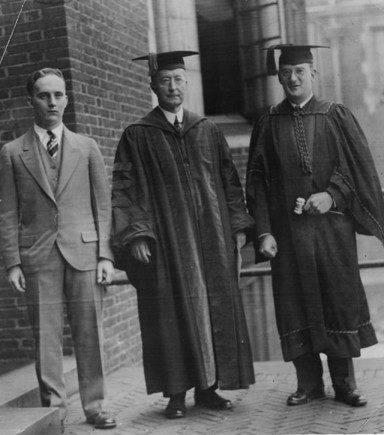
Walter O’Malley (far right) on graduation day from the University of Pennsylvania on June 16, 1926. O’Malley was selected as “The Spoon Man,” an honor emblematic of the outstanding overall graduating senior.
“An interesting thing, when I got to college, I was elected senior class president and chairman of the student council,” said O’Malley. “And with those two positions went the privilege of serving on one of the most important sports committees on the council on athletics. Up until this time, the senior president had always elected to go on the football committee. But for some reason, and I really don’t know why, I elected to go on the baseball committee. And I was the first senior president to ever do that. There must have been something lurking in my system somewhere at that time because I went the baseball route instead of football.” Walter O’Malley interview with Vin Scully for Union Oil record series, 1966
He continued, “I was there (at Penn) from 1922 until I graduated in 1926. I was in the college and my degree was Bachelor of Arts. But, in the last two years, you are permitted a great many elective subjects and I took most of my elective subjects in courses that would lay the groundwork for engineering, in the event I wanted to make that a career or a profession.” Walter O’Malley on KFI Radio with host Loren Peterson, 1965

As the winner of the prestigious “Spoon Man” award at the University of Pennsylvania in 1926, Walter O’Malley graduates as the outstanding overall student in his senior class.
He was Salutatorian of his senior class at Penn and won the “Spoon Man” award as the outstanding overall student in 1926. It was while at Penn that O’Malley began corresponding regularly with Katharina “Kay” Elizabeth Hanson, a beautiful, shy young woman whom he had decidedly had his eye on from childhood. He frequently wrote whimsical notes to her about the goings on at college, as she was nearly four years his junior. A regular writer herself, Kay responded to O’Malley’s charming anecdotes with her own stories from home and later from the College of New Rochelle, where she was graduated.
Kay was the daughter of Peter and Elizabeth Hanson of New York. Peter Hanson and Edwin O’Malley, Walter’s father, were neighbors and friends.
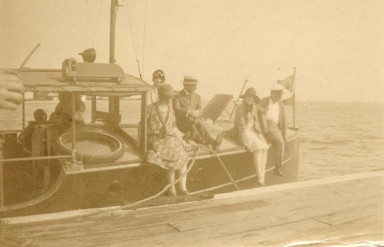
Neighbors Kay Hanson and Walter O’Malley (right) on a boat trip with friends and family.
Hanson was a judge in Brooklyn Domestic Relations Court, who protected children’s rights. Born in Sweden, his family moved to Brooklyn when he was six. He graduated from New York Law School in 1900. For 16 years, Hanson was President of Swedish Hospital in Brooklyn. His wife, Elizabeth, was a housewife, the daughter of Philip and Katherina Geyer, both of German descent. Hanson had two daughters — Katharina (Kay), the eldest and Helen, five years her junior.
While the two knew each other growing up, Walter O’Malley and Kay Hanson, were like any other neighbor kids, doing all the fun activities to pass the time. They did not develop their love story until much later.
“Kay’s folks lived in the house next to ours in Amityville, Long Island,” said O’Malley. “We were on the Great South Bay and we liked fishing and boating. I saw her grow up — she’s younger than I, of course. Gradually, it led into romance.” Ibid.
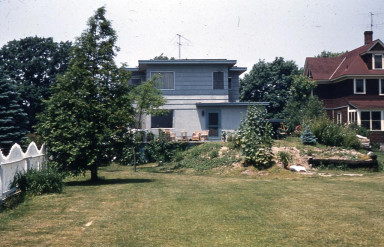
The O’Malley’s family summer home (left) next door to the Hanson home in Amityville, NY.
O’Malley continued his education, now with an interest in studying law, even though his undergraduate work specialized in engineering. Appreciating his dedicated studies and knowing his love of boating, O’Malley’s proud parents presented him a cabin cruiser as a graduation gift. The boat was later donated to the U.S. Coast Guard during World War II.
After graduating from Pennsylvania, O’Malley attended Columbia Law School in 1926, where he had enrolled prior to his father, Edwin, losing the family’s savings in the stock market crash and Depression. Walter juggled three jobs simultaneously and transferred to New York’s Fordham University School of Law, where he could somehow sneak in his law education at night. Fordham’s School of Law was housed on the 28th floor of the Woolworth Building, which was then the world’s tallest building. One of O’Malley’s night school classmates was New York Congressman Eugene J. Keogh, for whom the famed “Keogh Plan” is named. While completing his degree at Fordham in 1930, O’Malley gained valuable experience working in the offices of Judge Hanson.

